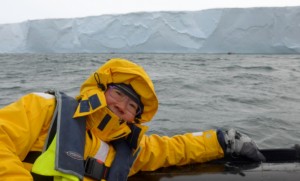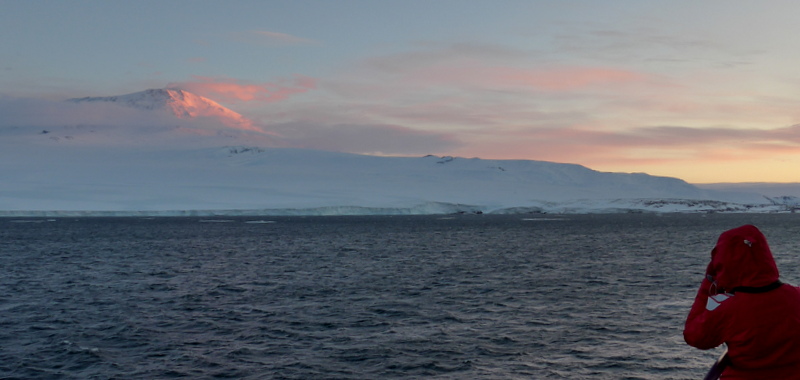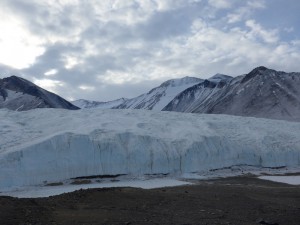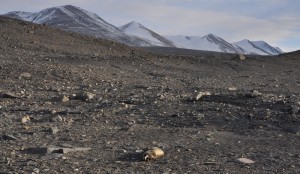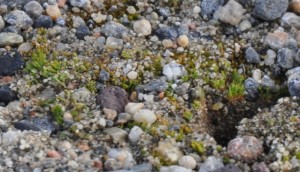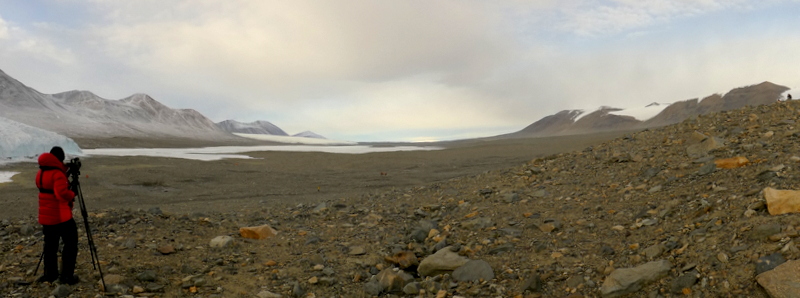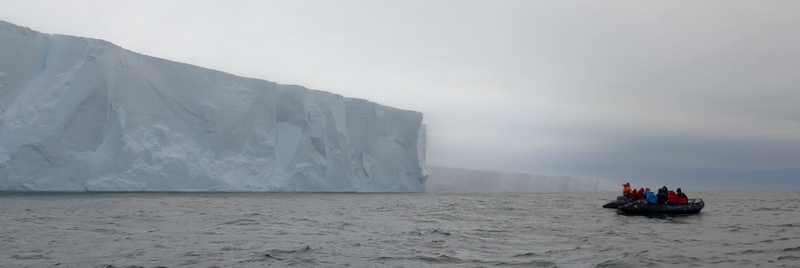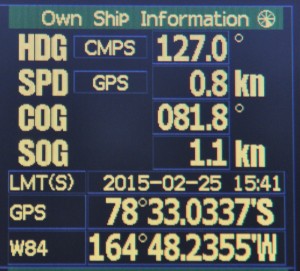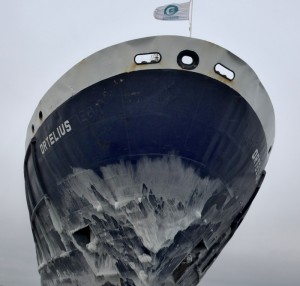February 23 – March 2, 2015 (Day 13 – 21 ): Dry Valleys, Ross Ice Shelf & Amundsen Sea
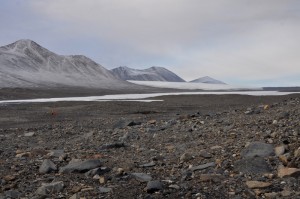 |
Day 13 (February 23, Monday): Cape Evans & Taylor Valley- Noon position: 77º 34’S 164º 36’E; Wind SE Force 8; Air -6ºC; Fifth Landing
Don hopes to arrange a zodiac landing at Cape Evans at 4am and a helicopter landing at the Dry Valleys in the afternoon. I get up most reluctantly at 3am and put on six layers of clothes, two pair of socks and the heavy boots. Then Don breaks the bad news that the zodiac cannot operate when the wind is blowing at 40knots an hour. Nothing we can do but wait!
I go up to the deck and enjoy the scenery. The view of Mt Erebus bathing in pink twilight is most beautiful and unforgettable. As the wind does not drop, Don takes a hard decision and decides to move on. I feel sorry as I shall unlikely to have a second chance to come all the way to this part of the world and visit Scott’s hut.
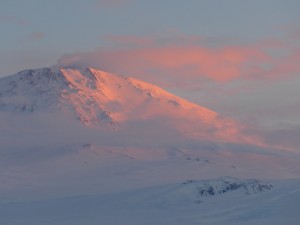 |
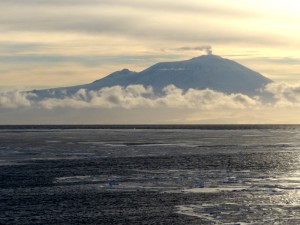 |
The journey back to the New Harbour is smooth taking only three hours this time. But the ghastly wind is still blowing around 40 knots. A reconnaissance flight takes off at noon and Don finds the conditions good enough for the helicopters to fly. Great news!
The Dry Valleys measuring 40km-wide and 80km-long, is the largest of its kind in the continent. It is the driest place on the planet and its landscape is eerie and surreal – with two colossal glaciers (namely Commonwealth and Canada), rigged mountains and an expansive dry valley. The valleys are free of ice because the Trans-Antarctic Mountains are so high that ice from the East Antarctic Ice Sheet does not spill over to flow down these valleys. In addition this area is incredibly dry – there is very little snowfall and this snow cannot accumulate as a glacier. Any snow that does occur, often sublimes straight to water vapour or is blown out by the extreme katabatic winds.
It is Group E’s turn to fly first (meaning my group – Group D would be the last to fly). The first flight took off after 1pm and my flight – Flight 22 (the last flight) does not take off till 6pm. It is the longest wait I have on this voyage!
I sit next to the pilot and have the best scenic flight of my life! It’s a unique experience: we fly over ice floes and newly forming sea ice, then over the land without snow/ice in the middle and with the gigantic Commonwealth and Canada Glaciers on one side and a low range of hills which are not snow-covered on the other. As the previous day’s storm has left a thin layer on the higher ground and on some of the boulders, the valley looks less dry!
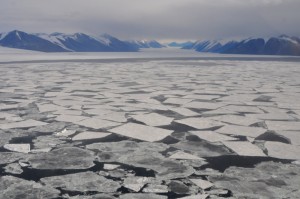 |
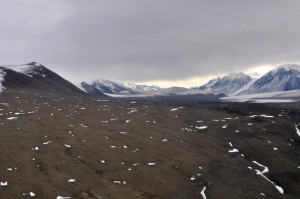 |
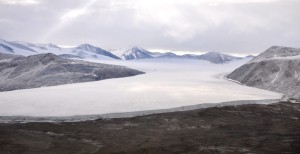 |
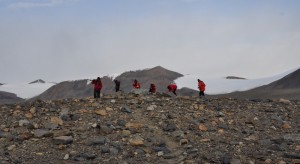 |
The helicopters lands at the foot of the Canada Glacier, which forms an elephant’s foot or piedmont glacier as it emerges from its restrictive Canada Valley into the main dry Taylor Valley. In front of the glacier are a few ice blocks produced by an extremely low rate of calving. In the hottest days of the year these will melt and flow into nearby Lake Fryxell, which today is completely frozen. The interior of this lake is always frozen but on the hottest days of the year a thin moat of water will form around its edges.
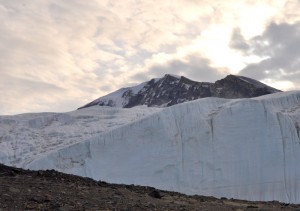 |
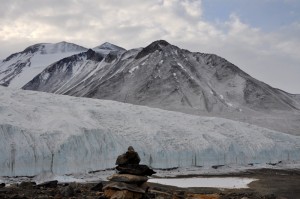 |
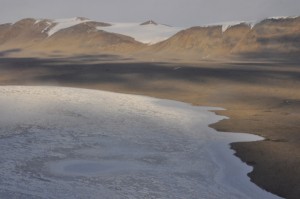 |
On the valley floor, at our landing site, are three mummified seals. These unfortunate beasts had once made the wrong call, and crawled in the wrong direction to find the sea. Eventually they died. But owing to the low humidity and cold conditions, they have been perfectly preserved. One of these seals has been dated at 2000 years old. Also on the valley floor are a large assortment of different rock types, but all are either igneous or metamorphic. Despite being the driest place on earth, moss manages to grow.
How many people on earth have visited the Dry Valleys? I am the lucky few who can wander around here for half an hour. I walk up to a vantage point affording panoramic views of the Canada Glacier and the whole valley.
 |
I am back on the ship at 7:20pm. After dinner, I stay on deck to enjoy the splendid and surreal scenery: over 100 km of coastline, several mountain ranges, glaciers and ice fields seem floating in soft and golden sun rays. 
I reckon it is the first nice sunset for almost half a month at sea. Around 10pm, I ask Don whether the sunset colours would change further. He thinks the scenery would remain more or less the same and he himself would be going to bed. I follow his advice and went to bed before 11pm. The following day, my friends said the colours of Mt Erebus around midnight were spectacular and worth watching. I wish I had stayed up for another hour! (L-chicken curry & rice; D-buffet: fish and veal)
Day 14 (February 24, Tuesday): At sea off the Ross Ice Shelf- Noon position: 77º 29’S 175º 38’E; Wind calm; Air -8ºC; Crossing the International Date Line; 2 lectures
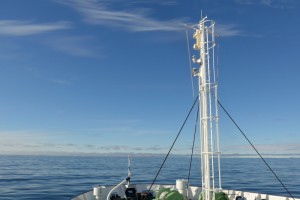 |
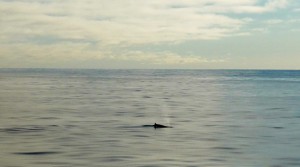 |
We cruise eastward in variable sea conditions with the Ross Ice Shelf visible on the starboard side – a continuous line of ice cliffs with some tabular icebergs in front. The sky is shrouded in misty cloud. The temperature drops to -8C with snow flakes.
We begin to appreciate just how big the Ross Ice Shelf is – over 300 nm (550 km) of continuous ice cliffs at the edge of the ice shelf. I stay at the bridge after breakfast and watch a couple of Minke whales swimming close to the ship
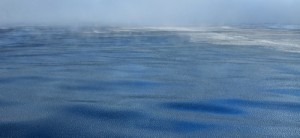 |
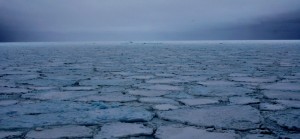 |
Gary gives a good introduction on penguins which comprises 17 living species namely the Emperor, King, Little, Yellow-eyed, Humboldt, African, Magellanic, Galápagos, Chinstrap, Gentoo, Adélie, Fiordland, Snares, Erect, Macaroni, Rockhopper and Royal Penguins. I love penguins and have seen 12 species so far. A tiny population of Galápagos Penguins live around the Equator while 15 species live in sub-antarctic and temperate regions. Only Emperor and Adélie Penguins regularly breed south of the Antarctic Circle.
After lunch, Rob, the hotel manager invites us to the deck for dessert. Wow, we have hot chocolate with rum or bailey and cake with cherry. It is a most beautiful day with excellent visibility: I can see some 100nm of the ice shelf. In the afternoon, John, NZ government’s representative, tells us about his studies of geology, sediments and lakes in the Dry Valleys back in the 1970s. I wish I could have such opportunity to live and work in the Antarctica.
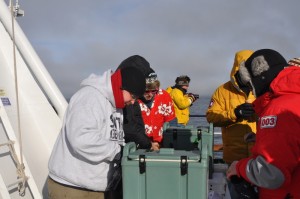 |
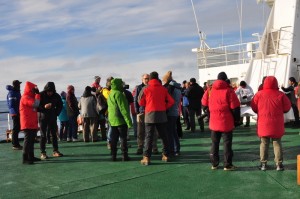 |
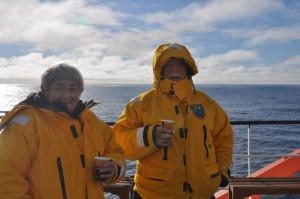 |
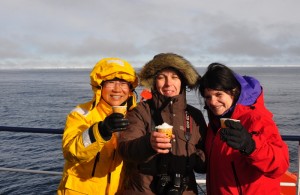 |
The major event of the day is the crossing of the International Date Line. I join the crowd at the bridge to celebrate by photographing the GPS screen.
Tonight, I watch ‘ The Whale Rider‘, a film that tells the origin/legend of the Maori. After my recent visit to NZ, I understand more about the culture and the story line. (L-beef ragout and pasta; D- fish)
Day 15 (February 24 Tuesday Again): Ross Ice Shelf & Bay of Whales- Noon position: 78º 24’S 166º 22’W; Wind SSE Force 9-10; Sea state 5; Air -11ºC; Third Cruise.
We sail along the Ross Ice Shelf the whole day. It’s the coldest day on this voyage with temperature dropping to -11ºC and wind speed at 70 knots. Such conditions undoubtedly slow down the ship. Life goes on and I attend James’s morning lecture on glaciers which come in all shapes and sizes. The largest in size is the continental ice sheets as found in Greenland and Antarctica. As a result of global warming, we are losing ice which can have serious consequences on climatic changes.
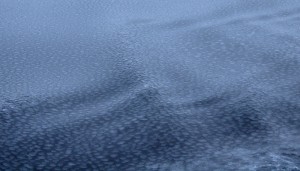 |
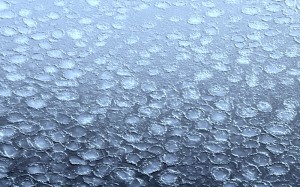 |
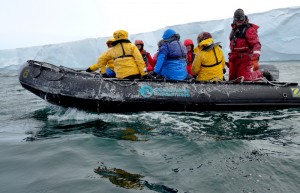 Around noon, we come close to the Bay of Whales where Amundsen wintered over before his successful 1912 trek to the South Pole. We finally reach 78º 33.159’, S 164º 42.00’ W, the southernmost point on our journey: only early explorers and few ships have ever reached this point!
Around noon, we come close to the Bay of Whales where Amundsen wintered over before his successful 1912 trek to the South Pole. We finally reach 78º 33.159’, S 164º 42.00’ W, the southernmost point on our journey: only early explorers and few ships have ever reached this point!
Around 2pm, we still have 60 knots of wind. While waiting for the wind to die down, we take turn to visit the bridge where Don, the Captain and his mates show us various instruments and map reading.
At 3:30pm, we are delighted to learn that the wind has dropped to about 35 knots. Zodiac operation can begin to take us to the edge of the ice barrier. As it is freezing, I have to put on all the warm clothes I have!
The zodiac covered in ice is slippery and dangerous. Some passengers decide to skip this adventure. The swell makes it even more difficult to get into the zodiac. Sitting at the front of the zodiac, I held tightly onto the rope in order not to fall into the water or down to the icy floor (both would have fatal consequence). The ride is bumpy, uncomfortable and freezing. Our zodiac driver by Jim did not go as far as Gary’s zodiac which reached 78º 36.5’ S, 164º 41.9’ W. It’s snowing and my fingers are frozen. Hence, I only take a few photos.
The brave Lewis has his swim here-the southernmost swim in history. We have been hoping for a helicopter flight over the ice shelf. Unfortunately, the poor weather has robbed us off this once-in-a-lifetime opportunity. What a pity which this is an understatement! (L-hamburger, D-fish & rice)
8 Days at Sea (February 25 – March 4)
Day 16 (February 25, Wednesday): At Amundsen Sea- Noon position: 76º 06’S 159º 49’W; Wind SW Force 3; Sea state 2; Air -3ºC; Pack-ice; 2 lectures (GMT -11)
As usual, the weather changes all the time. The temperature begins to rise and I feel much warmer as compared with the day before. The ship has to slow down to 4 nm at times as the sea is covered with ice floes including one-year sea ice (1 to 1.5 m thick) and multi-year sea ice (2 – 4 m thick and sometimes piled up much higher from winter pressure-ridges) and bergs of all shapes (square or angular) and sizes. The tallest tabular bergs might be 30-50m high and several km long with many spectacular grottoes.
The scenery is fantastic and bewitching: I spend a lot of time at the bridge and on deck. Around 10am, we watch a dozen of Minke whales swimming about 1km in front of the ship. Then plenty of seals, Adélie and Emperor Penguins show up on float ice while snow petrels fly around the ship.
In the morning, Alan gives an informative talk on the seals of the Antarctic (namely the Crabeater, Weddell, Leopard, Ross Sea and Elephant seals). I have seen all except the Ross Sea Seal. It is so beautiful outside that for the first time I do not wish to go to the windowless lecture room for Carol’s talk on Shackelton’s 1907-1909 Nimrod expedition.
Tonight, Michael Martin begins his 4-part talk on his new photo book entitled ‘Planet Desert‘ and adventures in deserts. Who can travel to the most remote parts of the world in search of polar bears and to see the life of nomads in Siberia and to take photos? I am indeed fascinated by his adventures in cold deserts in the Arctic region including Iceland, Svalbard, Franz Josef Land, Tschukotka, Alaska, Yukon, Baffin Island, West & East Greenland and the North Pole. His photos are awesome!
(L-drumstick and pasta; D- loin of beef)
Day 17 (February 26, Thursday): Amundsen Sea – Noon position: 74º 25’S 1596º 26’W; Wind SW Force 8; Sea state 5; Air -2ºC; Pack ice & open sea; 2 lectures (GMT-10)
I cannot not sleep and stay at the empty bar since 5am. It’s a gray and dull day! In the morning the bridge is closed most of the time as the captain and his mates have to navigate through pack-ice. Some passengers are not happy with the closure as they cannot watch wildlife and scenery. Anyway, I still have a good time watching Crabeater Seals, several groups of Adélie Penguins, a few Emperor Penguins, Snow Petrels and Giant Petrels from the deck or the bar.
I attend Jim’s lecture based on his recently published book, “Shackleton – a Life in Poetry”. He tries to highlight Shackleton’s life as an explorer, his motivation, inspiration as well as private life. I picked up this book from the library on the first day totally unaware who is the author. I enjoy the book which gives me an idea of Shackleton as a person and congratulate him after the lecture.
After lunch, we spend over half an hour watching several group of Minki whales near the boat (30 or more). Apparently, several huge schools of krill are in the water nearby as showed up on the ship’s echo-sounder.
I enjoy Part 2 of Michael Martin’s talk which focuses on his adventures in deserts in the Northern Hemisphere including America, Sahara, China, India and Tajikistan.
Again, I have a sleepless night. So I stay up in the bar from 1:30 to 3am reading another book on adventures in the Antarctica. I eventually managed to have a short nap.
(L: stuffed cabbage; D- pig knuckle)
Day 18 (February 27, Friday): Amundsen Sea – Noon position: 72º 15’S 144º 46’W; Wind SW Force 4; Sea state 3; Air +2ºC; Open sea; 2 lecture (GMT-9)
We had good weather today with sunshine. I walked around the ship with only my down jacket on. The sea was calm with plenty of icebergs throughout the day. The ship was going at over 11nm an hour. To break the monotony of the voyage, a time-limited photo contest was held- photos must be taken and submitted by 3pm. Responses were lukewarm and only a few enthusiastic photographers submitted a dozen of entries.
I attended Carol‘s lecture on Amundsen’s 1910-12 expedition to the South Pole in the morning and Alan‘s talk on krill’s importance in the marine life in the Southern Ocean.
My afternoon was livened up by two events. First, I asked Marcus to tell me about his ski trip to the South Pole in 2013. He flied with four companions to 89ºS and spent ten days to ski to the Pole where he camped for three nights. He had to train for a year and had to haul a sledge with a load of 90kg. This would be my preferred way to reach the Pole instead of flying in and staying at the Pole for a few hours. But I am too old and weak to embark on this dream adventure!
Just before the recap, a pod of Orcas appeared and I managed to take a few photos with my automatic camera. Though the quality of the photos are not great, I am excited and may be the only lucky one to have several photos taken.
I watched Part 3 of Michael Martin’s wonderful talk on his travel desert travel in the Southern Hemisphere in Africa (Sahara, Char, Namibia and Botswana), South America (Chile, Peru, Bolivia and Argentina) and Australia. I love to follow his footprints to see the deserts in Africa and South America. I had a good sleep.
(L- ? ; D-loin of lamb)
Day 19 (February 28 Saturday): Amundsen Sea – open sea – Noon position: 70º 22’S 132º 21’W; Wind N Force 6; Sea state 3; Air +1ºC; 2 lectures
The weather remains fine and warm. The morning lecture by Dmitri on evolutionary origins of whales is interesting. I cannot imagine that their closest living relative was the hippopotamus! I also do not know whales have evolved from pakiscetus a mammal which lived in India/Pakistan some 45million years ago and evolved into a marine mammal some 20 million years later.
Around 11:15am, the news of two Humpback whales close to the ship comes and I rush out just in time to catch a glimpse of the whales with one blow and an arch. I take a picture of a fluke!
In the afternoon, Gary tells us most passionately about the lives and habits of his beloved Adélie Penguin based on his research. The big event of the day is an auction held to raise funds for the Antarctic Heritage Trust based in NZ for restoring and maintaining the historic huts. The auction went very well with many items being hotly contested. Patrick got the Oceanwide expedition flag signed by the crew and expedition team and passengers. Babis paid the highest price for a NZ$5 note signed by Sir Edmund Hillary. Someone got a bottle of limited-edition MacKinlay’s Scotch whiskey blended by the same distillery to match the whiskey recently found hidden under the floor of Shackleton’s Cape Royds hut. Over $6,000 is raised for a good cause.
After dinner, Michael Martin finishes off his talk with the cold desert – the Antarctica including the South Pole. This is his third visit to the continent. We are privileged to have a preview of his new book and listen to his amazing travel in deserts all over the world.
(L-braised beef and pasta; D-baked hake)
Day 20 (March 1 Sunday): Amundsen Sea –open sea – Noon position: 69º 56’S 120º 54’W; Wind NE Force 8-9; Sea state 5; Air 0ºC; 2 lectures (GMT-8)
Today is another day of open sea in fairly rough conditions with irregularly scattered icebergs, occasional seabirds and a few blows in the distance but no close-up whales.
In the morning, I join Alan’s talk and learn that thousands of albatrosses and petrels of the Southern Ocean are killed a year as a result of long-line fishing in the region. With international cooperation and the application of simple technology, the problem has come under control to some extent. Nonetheless, many populations of albatrosses remain severely depleted and long-line fishing by pirate fishers continues to kill seabirds. I hope something more effective can be put in place.
Today is St. David’s Day – celebrating the patron saint of Wales. James, a Welshman, begins his afternoon lecture on volcanoes of the Antarctic with the Welsh national anthem. He highlights various types of volcanoes and lava as found in the continent. Before dinner, we watch several spectacular tabular bergs with grottoes.
The evening entertainment is a film by George Clooney called ‘O Brother, Where Art Thou‘ (2000) which won him a Golden Globe Award. The strong southern accent and the weird plot are too difficult to appreciate. I have another sleepless night as the sea gets very rough creating too much noise.
(L-beef & rice; D-pork and seafood spaghetti)
Day 21 (March 2, Monday): Amundsen Sea – open sea – Noon position: 68º 58’S 111º14’W; Wind NE Force 8; Sea state 5; Air 0ºC; 2 lectures (GMT-7)
I sit in the bar writing and reading from 1am when I cannot sleep. Tonight there are many sleepless souls on board.
The Southern Ocean is huge! Our ship has been making decent progress for six days since leaving the Ross Ice Shelf but we still have three more sea days. Gary gives a fascinating account of his year spent studying Emperor Penguins near the Australian Mawson Base. In the afternoon Alan explains how penguins and marine mammals are able to function as extraordinary divers. Emperor Penguins and Weddell Seals can find food at over 500 m deep while Elephant Seals can dive to an unbelievable 1500 m. How they deal with oxygen deficiencies, pressure, cold and darkness at these amazing depths is a fascinating story revealed by modern research technology.
I have no ear for music and hardly know much about pop groups. Tonight we watch a video on the performance of Metallic – the only band that has played in all seven continent- on 8 December 2013 in a dome on the heliport at Carlini Argentina Base. The band travelled with Ortelius and the video was made by the ship’s physician, Rutker Stellke.
(L-pasta; D-fish-pan-fried hoki)


